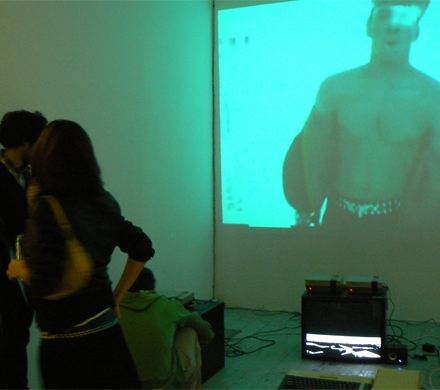Tha Click
E:vent presents a group exhibition of work by the American art crew Paper Rad along with Beige Programming Ensemble artists Paul B. Davis, Cory Arcangel and Joe Beuckman.
Seizing upon the technological detritus spawned by advancements in computing over the last three decades, Beige’s inclination is to tinker with the inner workings of ubiquitous platforms past and present. Paper Rad are similarly drawn to the gaudiest fixtures of pop culture, transmogrifying and amplifying them into a kaleidoscopic parallel universe all their own.
This linked aesthetic has its origins in time spent working together while studying at Oberlin College in Ohio in the late 1990s. Here, these artists cultivated a rich multidisciplinary practice that blurred the lines between art, music, computer programming and design, all within a social framework characterized by collaboration and flexibility.
If the material qualities of Paper Rad and the Beige artists’ work derive from outside of the conventional art landscape, so does their modus operandi; namely in the Do-It-Yourself music movement of the 1980’s. At the same time these artists were coming of age, musicians, labels, writers, designers and DJ’s were beginning a wholesale rejection of the straitjacket of corporatism in favour of a more personal and intimate mode of production.
The influence here is apparent - Beige’s own concept of ‘intentional computing’, a direct engagement with home computing hardware unmediated by programmers, is a technological illustration of the DIY impulse more readily apprehended in Paper Rad’s paintings, comics and hand-made paper works.
Tha Click illustrates these points with both new and early work from these artists. New large-scale technicolour prints by Paper Rad feature alongside dizzying video works, books, self-published comics and zines. Early Nintendo hacks by Davis and Arcangel have the artists break apart the cartridges and alter the code to create new landscapes or characters respectively, while Davis experiments with a technique for altering video by its code in a new projected piece. Listening stations feature the complete Beige Records catalogue, including the Atari-composed 8 Bit Construction set, the flipside of which reveals computer software playable on a console in the exhibition space. Intricately beaded sleeves custom-made for bottles of malt liquor offer an example of the wry humour that infuses these artists’ work. Documentation of their performance practice, whether a Paper Rad tour video or Beige’s improvised music videos, highlight the influence of independent music culture on their work.
In 1939 the art critic Clement Greenberg famously and erroneously dismissed kitsch as the enemy of the avant-garde artist. In 2007, Paper Rad and Beige’s work suggests that in fact the two were naturally aligned the whole time. Their embrace of what was once called ‘low-brow’ has produced work that elides knee-jerk accusations of pastiche or retroism. Instead, the artists’ work proposes an entire rethinking of what can be found in the contemporary mediascape.





